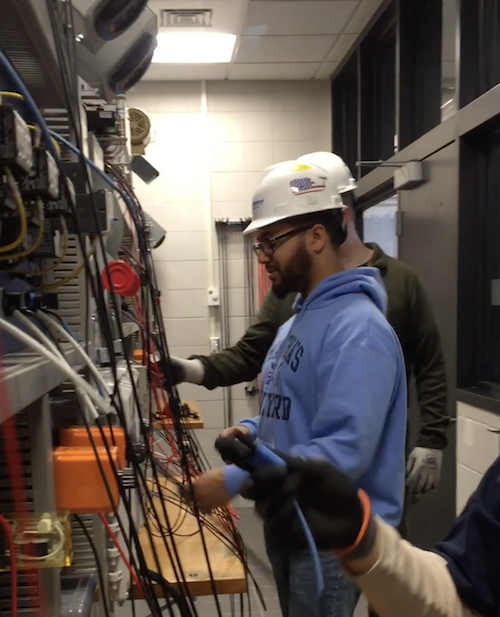Boston Local 103’s “Opportunity Campaign” is working to
extend the prospect of a better life through union membership to an
increasingly diverse array of Bostonians.

|
Local 103 used images of women and people of color in ads that ran both offline and online, including on social media platforms like Snapchat and Instagram.
Photo credit: 617MediaGroup
|
“Boston is a very diverse city,” said Local 103 Business Manager Lou Antonellis. “It’s important for our organization to not only represent, but resemble, our neighborhoods and our membership.”
Local 103 partnered with developer Millennium Partners Boston and 617MediaGroup, a communications firm, to create an outreach campaign using ads targeted to women and communities of color, two groups historically underrepresented in the building trades.
Using zip codes to geo-target their ads, which ran online and elsewhere featuring women and people of color, the campaign aimed to increase the diversity of Local 103 by increasing awareness of its apprenticeship opportunities.
It worked – really well.
“Local 103 is already the most diverse among the building trades in Boston,” Antonellis said. “This campaign doubled our applicant numbers.”
The roughly 8,000-member local received a record-breaking 687 applicants from the city of Boston, a 95 percent increase from the prior year. Among those, 452 were people of color — the largest number of minority applicants for a Boston construction apprenticeship ever, Antonellis said. Eighty-five of the applicants were women, including 57 women of color.
Of 2,100 total applications received from all over the region, Local 103 will choose about 250 for its apprenticeship program.
“I’m looking forward to welcoming our new apprentices to our training program and to our union,” said Local 103 business agent Kenell Broomstein. “We’re growing stronger and more diverse every day.”
Broomstein recently achieved a milestone herself when she became the first woman-of-color business agent at a major Boston area construction union.
“I’m extremely honored to take on such a high-profile job,” Broomstein said. “People need to be able to see themselves in these leadership roles. Then they can say, ‘Wow, if she can do it, then I can do it.’”
Broomstein also spoke at the annual Massachusetts Girls in Trades Conference and Career Fair, hosted by Local 103, for girls and educators in the area. Now in its third year, the March 20 event attracted more than 500 students from 28 schools.
At a time when the construction industry is dealing with a labor shortage, efforts such as Local 103’s can take on an increased importance. And the benefits go both ways. Union construction jobs, with their livable wages and benefits, have been shown to reduce racial and gender pay gaps.
On average, women make around 80 percent of a what man does in a comparable position. But in construction, the pay gap shrinks, with women making 96 percent of their male counterparts, according to the National Association of Women in Construction. Nationally, about 2 percent of construction workers are women. In Massachusetts, it’s closer to 7 percent, according to The Boston Globe.
A study by the Illinois Economic Policy Institute found that when prevailing wage laws are in place, African-American workers earn an average of 88 cents for every dollar their white counterparts earn. In states without prevailing wage regulations, African-Americans make only 74 cents for every dollar white workers are paid.
#Outreach
The campaign is notable not just for its impressive recruitment numbers but also for its use of social media, running ads on major platforms like Facebook, Google and YouTube, as well as those with a smaller overall audience but popular among younger, more diverse groups, like Instagram, Snapchat and Pandora, a popular internet radio site.
The ads were targeted to people of color aged 18 to 25 living in Roxbury, Dorchester and Mattapan, Mass. The campaign also ran ads on billboards and on television, both online and traditional, and in local print publications.
Antonellis says it’s the first time he knows of that a major Boston-area union has run such an aggressive social media campaign.
“Social media is the best tool to reach younger workers,” Antonellis said. “And platforms like Pandora, Snapchat and Instagram are where they’re spending a lot of their time right now.”
According to the Pew Research Center, 69 percent of all Americans use some form of social media. For people aged 18 to 29, the number grows to 88 percent.
Among the platforms used, Antonellis said Pandora was the most successful, along with Facebook.
The success was noticed by others in the building trades, Antonellis said, with some reaching out to see how they could replicate Local 103’s success.
“If you want to increase diversity in your local union, there are many ready, willing and able applicants out there; you just need to reach out to them,” Antonellis said. “And social media is one of the quickest, cheapest and most effective ways to reach your audience. I say jump right in, the water is fine.”